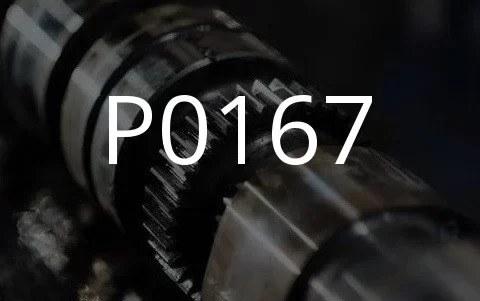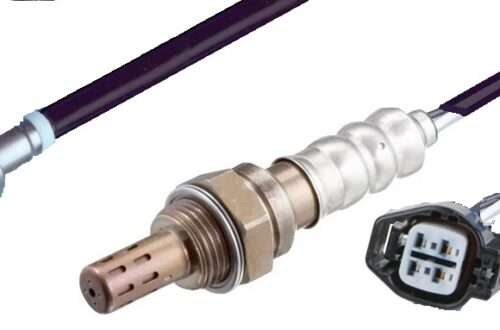
P0167 Oxygen Sensor Heater Circuit Malfunction (Sensor 3, Bank 2)
Content
P0167 – OBD-II Trouble Code Technical Description
Trouble code P0167 indicates a malfunction in the oxygen sensor heater circuit (sensor 3, bank 2).
What does the fault code mean P0167?
Trouble code P0167 indicates a problem with the oxygen sensor heater (sensor 3, bank 2). This oxygen sensor detects the level of oxygen in the exhaust gases and helps regulate the fuel/air mixture in the engine. When the ECM (engine control module) detects that the voltage on the oxygen sensor 3 heater circuit is too low, it indicates a problem with the heater or its circuit.

Possible reasons
Some possible reasons for the P0167 trouble code:
- Problems with the oxygen sensor heater: A malfunction in the oxygen sensor heater itself may be the cause of this error code. This may include a short circuit, open circuit, or broken heating element.
- Poor electrical connection: Poor or oxidized contacts in the connector or wiring associated with the oxygen sensor heater can cause insufficient power or ground, resulting in a P0167 code.
- Electrical circuit problems: Opens, shorts, or damaged wiring can disrupt the electrical circuit needed to operate the oxygen sensor heater.
- ECM malfunction: A malfunction of the engine control module (ECM) itself can result in a P0167 code if the ECM is unable to properly process signals from the oxygen sensor heater.
- Problems with the catalyst: In some cases, problems with the catalytic converter or other exhaust system components may cause this error to appear.
- Mechanical damage: Mechanical damage or cable damage can cause problems with the oxygen sensor heater and lead to P0167.
To accurately determine the cause, it is recommended to carry out diagnostics using appropriate equipment.
What are the symptoms of a fault code? P0167?
Symptoms for trouble code P0167 can vary:
- Increased fuel consumption: Improper functioning of the oxygen sensor may result in an incorrect mixture of fuel and air, which may cause increased fuel consumption.
- Loss of power: Improper fuel/air mixture can also cause loss of engine power or rough operation.
- Unstable idle: If the fuel/air mixture is incorrect, the engine may idle rough, which may result in shaking or rattling.
- Exhaust smell: An incorrect mixture of fuel and air may result in an unusual exhaust odor from the exhaust system.
- The Check Engine light comes on: When P0167 occurs, the ECM will record this code and illuminate the Check Engine light on the instrument panel to alert the driver that there is a problem with the exhaust system or oxygen sensor.
These symptoms may manifest differently depending on the specific conditions and type of vehicle.
How to diagnose a fault code P0167?
To diagnose DTC P0167, the following steps are recommended:
- Check the error code: Use an OBD-II scanner to read the P0167 error code from the engine control module (ECM) memory.
- Check wiring and connectors: Inspect the wiring and connectors associated with the oxygen sensor for damage, oxidation, or breaks. Make sure all connections are tight and secure.
- Check the oxygen sensor heater: Check the oxygen sensor heater for shorts, opens or damage. Check the heater resistance in accordance with the manufacturer's technical documentation.
- Check supply voltage and grounding: Using a multimeter, check the supply voltage and ground on the oxygen sensor heater circuit. Make sure the voltage is within acceptable limits.
- Check ECM status: In rare cases, when all of the above checks do not reveal a problem, the engine control module (ECM) may be faulty. However, this should be considered as a last resort after careful investigation of other possible causes.
- Test the system to see if it works: After fixing the detected problem, do a test run to make sure that the error no longer appears and the system works correctly.
If you are unsure of your diagnostic skills or do not have the necessary equipment, it is recommended that you contact a professional auto mechanic or service center for a more accurate diagnosis and resolution of the problem.
Diagnostic errors
When diagnosing DTC P0167, the following errors may occur:
- Oxygen Sensor Heater Diagnostics Skip: Some technicians may not check the oxygen sensor heater or skip this step when diagnosing, which may result in incorrectly determining the cause of the error.
- Faulty wiring and connector diagnostics: Improperly diagnosing the wiring and connectors associated with the oxygen sensor can result in a problem being missed if the technician does not look for damaged or oxidized wiring.
- Faulty interpretation of test results: Incorrect interpretation of oxygen sensor heater or wiring test results may lead to incorrect identification of the source of the problem.
- Need for specialized equipment: An accurate diagnosis may require specialized equipment that is not available to all auto mechanics.
- Errors during troubleshooting process: If the detected problem was not corrected correctly or some important action was ignored, the problem may reoccur after diagnostics are carried out.
- Defective ECM: In rare cases where all other components have been checked and ruled out and the problem remains, there may be a problem with the Engine Control Module (ECM) itself, which may be undiagnosed or underestimated.
To prevent these errors, it is important to have the diagnosis performed by a qualified technician who has experience with these types of problems and access to the necessary equipment.
How serious is the fault code? P0167?
Trouble code P0167, which indicates a problem with the oxygen sensor heater, can be more severe or less severe depending on the specific circumstances. Several factors that can determine the severity of this code:
- Increased emissions of harmful substances: If the oxygen sensor heater is not functioning properly, it may result in increased emissions from the vehicle's exhaust, which may have a negative impact on the environment and may result in vehicle inspection problems.
- Loss of performance and fuel economy: Incorrect operation of the oxygen sensor heater can result in loss of engine performance and reduced fuel economy as the ECM may be in a lean mode to prevent catalytic converter damage.
- Damage to catalyst: Insufficient oxygen in the exhaust system due to a faulty oxygen sensor heater can damage the catalytic converter, requiring costly repairs.
- Potential problems with passing technical inspection: In some jurisdictions, a vehicle may be rejected for inspection due to a fault related to the oxygen sensor heater.
Overall, although a P0167 code does not always indicate a critical problem, it should be taken seriously due to the potential effects on vehicle performance, fuel efficiency, and harmful effects on the environment.
What repair will help eliminate the code? P0167?
To resolve the P0167 trouble code, you typically perform the following steps:
- Checking wiring and connectors: The technician should first check the wiring and connectors associated with the oxygen sensor heater. This includes checking for damage, corrosion or breaks, and checking that the connectors are intact and connected correctly.
- Checking the oxygen sensor heater: A technician should check the oxygen sensor heater itself for proper operation. This may include checking the heater's resistance with a multimeter to ensure it meets the manufacturer's specifications.
- Replacing the oxygen sensor heater: If the oxygen sensor heater does not work or its resistance is out of range, you must replace it with a new one that is compatible with your specific model and make of vehicle.
- Diagnostics and replacement of PCM (if necessary): In rare cases, it may be necessary to diagnose and replace the Engine Control Module (PCM) if all other components have been tested and are functioning properly.
- Clearing errors and rechecking: After completing the repair, the technician should clear the errors using a diagnostic scan tool and recheck the vehicle to ensure that the P0167 code no longer appears.
It is important to follow these steps consistently and carefully to ensure that the oxygen sensor heater system is fully functional and to avoid reoccurring code P0167. If you are unsure of your skills or experience, it is best to contact a qualified auto mechanic.
P0167 – Brand-specific information
Trouble code P0167 refers to the oxygen sensor heater system. Below are the decodings of this code for some specific car brands:
- Chevrolet / GMC: Bank 3 No. 2 oxygen sensor heating error.
- Ford: Heating oxygen sensor (O2) No. 3, bank 2, out of range.
- Toyota: No. 3 Bank 2 Oxygen Sensor Heater Circuit Voltage Too High.
- Honda: Oxygen Sensor Heater 3 Bank 2 Voltage Low.
- BMW: Bank 3 oxygen sensor 2 heat signal mismatch.
- Volkswagen/Audi: Bank 3 oxygen heater 2 voltage is too high.
These are just general interpretations of the P0167 code for different makes of vehicles, and the specific meaning may vary slightly depending on the model and year of the vehicle. For accurate diagnosis and repair, it is recommended that you consult your service manual or a qualified auto mechanic.
